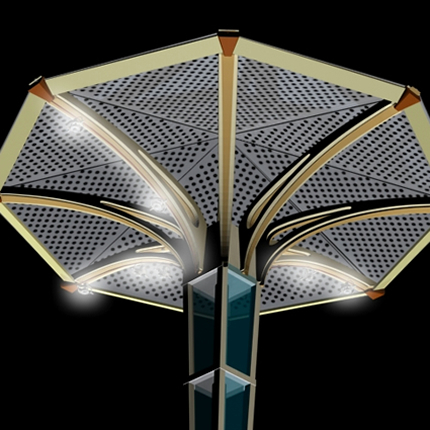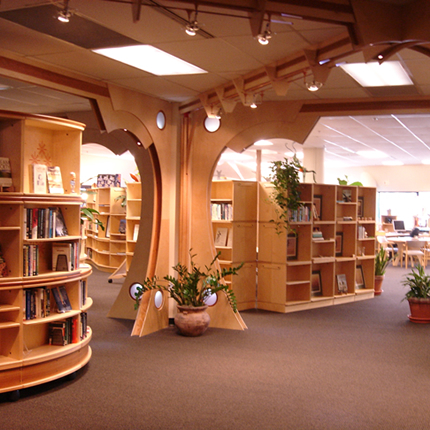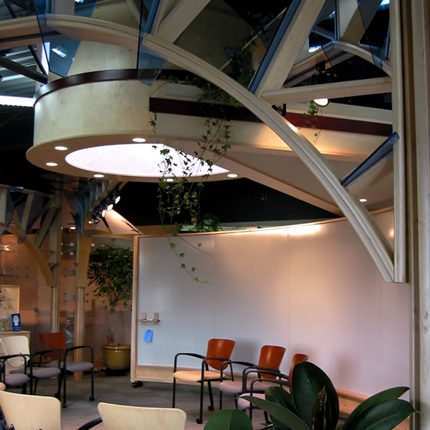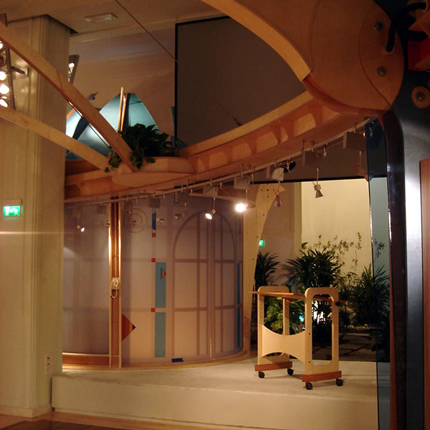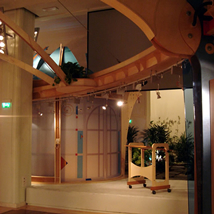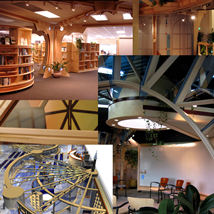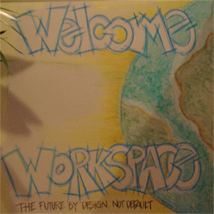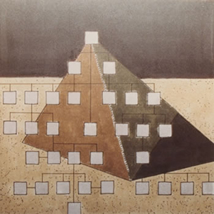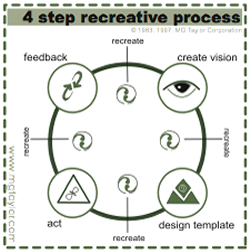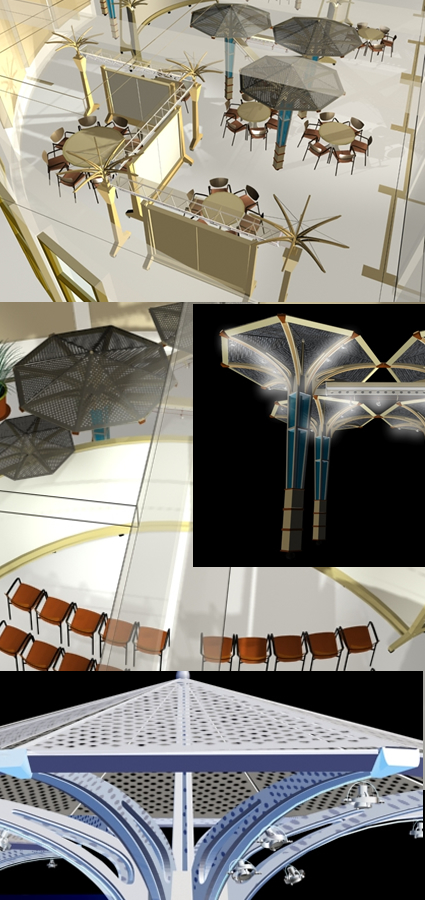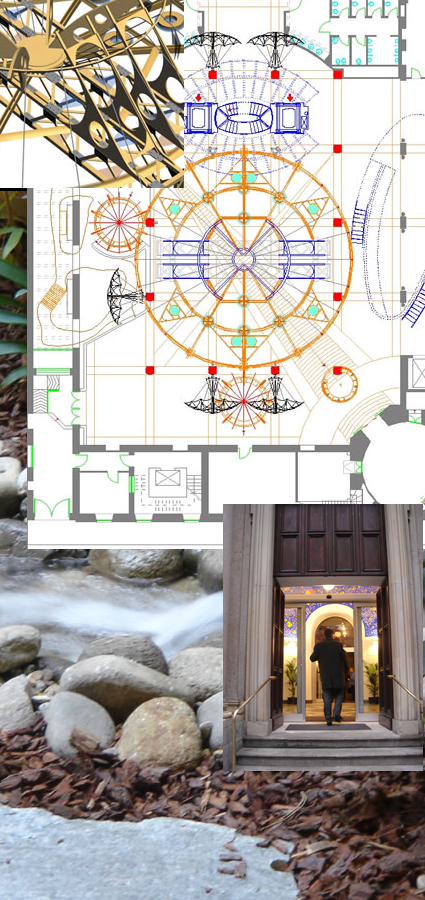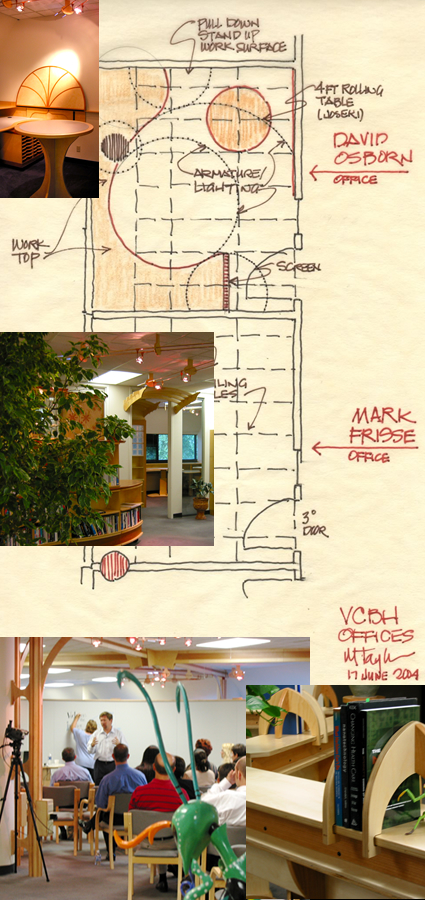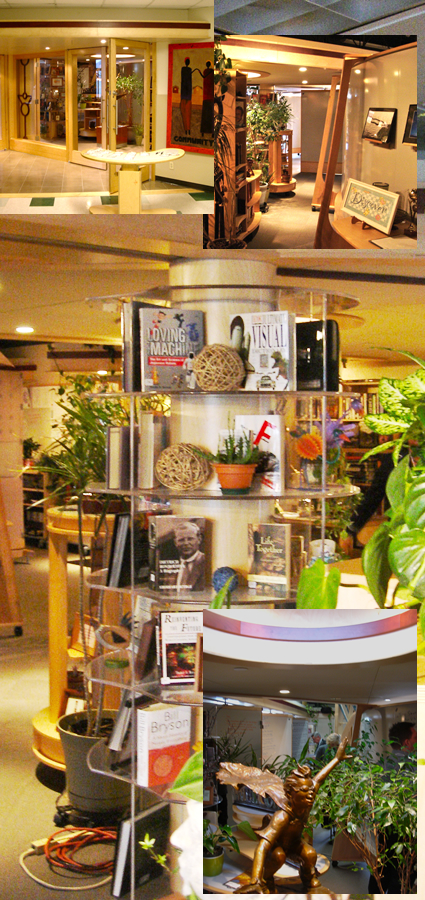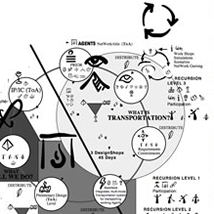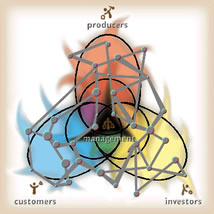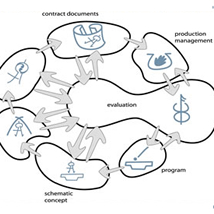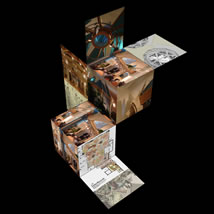the Making, Ownership and Use of navCenters |
click on drawings above for background on the projects illustrated - the links change for each of for four pages of this documentation |
how to conceive and realize a new armature for creative work |
| The first Taylor navCenter™ was built in 1982. Since then, over fifty, of various sizes, types and application, have been built with fifteen new projects on the drawing boards in 2010 alone. Of the first fifty, about twenty-five percent are in operation today. So far, navCenters tend to remain in operation for five to seven years - the life cycle of their original project task - or, for much longer when owned by organizations who grasp their value and mission beyond the successful execution of a necessary project of some moment in time. |
| navCenters have a mission and while it includes providing useful work and transformational results for each owner-operator, accomplishing this mission involves facilitating transformational projects which are global in scope and thread across multiple organizations of all kinds: businesses, NGOs, governments and learning institutions. These objectives drive the dual requirement of building a system capable of supporting global transformation while being a self-financed, profitable enterprise with local ecological/economic viability. |
|
| It is accurate to say that the navCenters we are building today are just becoming the full expression of our early 70s concept and early 80s designs. |
| There are good reasons for this. First, the concept from its inception was a bold one resting on a quarter of century of research, design and prototyping work. Second, the technology necessary to support the navCenter OS is just now coming into being at an affordable cost. Third, the market which recognizes the need for this kind of capability is just beginning to develop. navCenters were way ahead of their time. Starting their development when we did was a necessary practice of anticipatory design. The incubation period was long as the concept required multiple iterations of design-build-use to refine the system. To be ready at the moment the need emerged - this being an unpredictable time - required that we start decades early. This said, the built navCenters have created millions, and in several cases, billions of dollars of value for those who used them. |
|
page one overview description & history of five |
scope of this documentation |
| The focus of this document is provided though the lenses of four navCenter types three of which, Unicredit, VBCH and Masters, have been in operation for several years. A long stay RDS with full navCenter capabilities has never been deployed. However, a few hundred RDS deployments to many nations for multiple different uses, have been made since 1982. Although every navCenter is unique, the generalizations in this document are based on long experience and the cost numbers consistent with building in the San Francisco Bay Area into the first quarter 2011. |
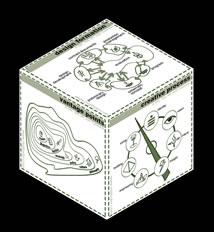 |
The SolutionBox voice of this document is: Vision of the concept of navCenters, Strategy in terms of achieving their building and use, and Evaluation of built works and their operational history. |
|
click on the SolutionBox Model for explanation |
| A single human is complex. A team far more so. Organizations and Humanity as a whole - and the ecology we live in - adds up to a complexity that cannot be understood, predicted or controlled. Yet, each of us everyday does impact both our local communities and the whole. The resulting complexity is staggering and amazing in its benefit and potential risk. |
| In our society, exiting work processes and organizational structures emanate from 10,000 years of history with the remarkable inventions of the Industrial Era piled on top of old paradigms. They have become Variety generators. We have created a huge human hive, dazzling in its many multifaceted parts, yet lacking the coherence of the single untrained mind of a child. Our institutions are not able to respond to this. Our biological systems, while connected and mutuality impacting in may ways, are not “wired” to provide the mind-like connectively required by the circumstances created by the sum of our billions and billions of daily activities. The tools and technologies we are creating are growing the capacity to do this yet they still promote processes of too simple a kind. More often than not they make the variety equation worse by amplifying the wrong data, in the wrong way at the wrong time. |
| Can we have our abundant variety and coherence even without understanding and control? Yes. It requires applying what we know about cybernetics systems, complexity and emergent properties to the way we organize, design and act. |
| Control cannot be applied externally to a complex system - it must be a built in organic governor. Scales of systems have to be connected the same way. This is how the human organism works and apparently so does all of reality. The navCenter ValueWeb is designed to start this process. |
|
|
use of this documentation |
| This documentation, pages one through five, describes a complex phenomenon through the detailed look of four projects. This is impossible to do unless the reader follows the many links provided. The navCenter practice is an O.S. for a community of work exercised within an environment which is based on a platform Armature, augmented by technology which facilitates use of the Ten Step Model of the Taylor System and Method. These environmental attributes function as a synergy to make a mind-like response from all of the Agents working within the space. We call the result GroupGenius®. |
| The navCenter is a social invention created to solve a set of specific problems endemic to our time in which Humanity is being overwhelmed by the rate of change and increase of complexity of our own making. As an O.S., navCenters radically decrease the time from idea to execution, improve the precision of planning and execution, provide requisite variety of those working a chosen problem with the inherent complexity of the problem, facilitates creativity and innovation, and transforms local capacities into a functioning global network capable of working with cross boundary, complex, emergent, systemic issues. navCenters were conceived in the 70s and have been practiced by continuous rapid prototyping (design-build-use) to provide a system integration function to the totality of resources, capabilities, capacities and human genius which at any time is brought to bear on an important problem/opportunity. |
| All work is local. All systemic issues are global. NavCenters provide the Armature for connecting both through multiple levels of organizational recursion from individuals, teams, groups, organizations, communities and larger ecological/economic units and up to global scale. It is an organizations’s ValueWeb, which span these scales, which matters now. |
| Every navCenter owner-user organization has their own piece of work - their own part-of-the-whole they have carved out to focus on. Yet, all systems overlap and impact one another in a connected world going through rapid transformation. Completely unconnected work leads to unintended consequences. Independent (Patches) and connectivity (Knodes) have to co-operate at a high frequency low magnitude rate and scales of size to avoid systemic failure. The navCenter tool provides this function. |
| Those who seek to explore the navCenter concept and practice will naturally have their own focus and purposes and will approach their inquiry from this perspective. This is good and necessary yet can be limiting and misleading. The purpose of this documentation is to provide a layered explanation of the NavCenter concept and practice - past, present and future - so that each of you can find your own way to the answers you need yet do so always within the understanding of the totality of the practice. |
|
|
four navCenter types as examples for this documentation: |
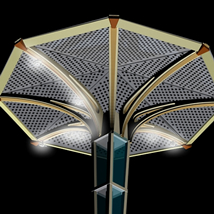 |
| The first RDS with Armature was designed for the WEF in 2006 yet not implemented. RDS units have been deployed hundreds of times, from a few days to a couple of years, in support of DesignShop events® and to accomplish follow on work. A full service RDS navCenter has never yet been put to use although recent use trends indicate that such units will soon proliferate. |
click on graphic for more detail |
|
| 1982 - 2010 THERE to HERE |
There are 7 Domains of the Taylor System and Method which outline all of the operating functions of the Method and the expressions of it in the present form of DesignShops, navCenters, PatchWorks processes and ValueWeb organizational structures. These 7 Domains can be chunked into three groups: Environment, Process, and Augmentation Tooling. Every navCenter mixes these three elements differently in response to user requirements, circumstances, the work mission and the resources made available. |
The various Environment, Process and Tooling combinations have been tested since 1982 as have many financing, ownership and operational practices. This has been a continuous rapid prototyping process of client Centers and those owned and operated by MG Taylor. While the variety of possible navCenters is near infinite, certain pattern Language principles have emerged as measures of viable results. The concept was clear back into the 60s and 70s, developing the practice to its present level has taken nearly two decades. This practice level still lags behind the concept. No one navCenter has yet to achieve all of it. Yet each Center exemplifies, in some areas, the present state-of-the-art. This is one, yet only one, reason why a functioning ValueWeb is necessary to create and maintain navCenters. |
It takes a great deal of reading and dialog to understand the Taylor process. This is true of any complex system such as our everyday work processes. The present and dominate process of work is in place and has grown over a long time. A new way of working has to be designed, built, used, learned and communicated in a fraction of that time. For the users of the process, it is actually easier to do than to know what it is. It is the sponsorship and the providers who have to learn it by the only method which works: by doing it with those who have mastered it. After all is said and done, the explanation is simple: we build and operate the most viable future environment we can and invite people and groups to come into it and design and implement their preferred future. |
|
|
| UniCredit navCenter was designed and built in 2006 and opened in January 2007 in Turin, Italy. It is, as of 2010, one of the largest and fully equipped navCenters in the ValueWeb with extensive media augmentation capability. The UniCredit Centers provides extensive education and training services as well as collaborative design events for the entire corporation and its clients. |
click on graphic for more detail |
|
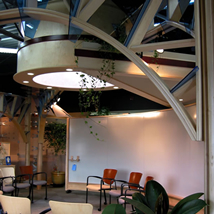 |
The Masters navCenter is the only one in a school and dedicated to the transformation of education. Used by administrators, teachers, students and parents to develop the school, its curriculum and to advance education methods, the navCenter works closely with Masters Arts Lab and annual Future Fairs where students develop a future world for student’s and parent’s participation. |
click on graphic for more detail |
|
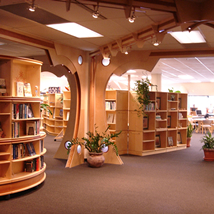 |
| Vanderbilt navCenter is dedicated to the transformation of health care and its delivery. Built in 2002, it represents the best example of a navCenter being employed to steward a long range plan designed to achieve systemic results over a 15 year term. At present, the VCBH navCenter is closest to practicing the full range of the Taylor Method by utilizing about 30% of the System. |
click on pictures for more detail |
|
|
| 1982 sketch of the navCenter showing the CyberCon augmentation process and technology supporting self-managed teams. This concept integrates laptop computers, SI workstation, PDAs, electronic walls and RemoteCollaboration.™ |
|
| 1990 Layout for Capital Holding offices with PODs, cube-office system, Armature, zones, “roads and alleys,” and adjustable collaborative work areas while meeting the density requirements of a standard static layout. |
|
| 1991 Capital Holding navCenter, the first with a fully integrated, computer, media system and the size - at 1,100 square feet - to offer dual DesignShop events simultaneously with ongoing project team work. This Center was built in 90 days. |
|
| 1999 diagram for manufacturing all of the platform components necessary to economically and swiftly implement the System, in multiple variations, each with an unique brand look for the operating enterprise. |
|
|
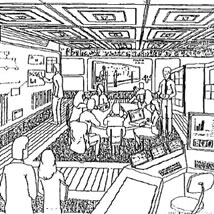 |
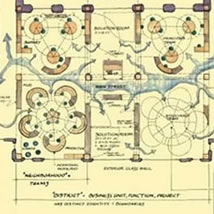 |
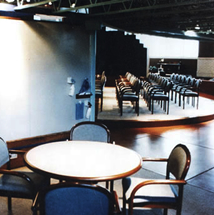 |
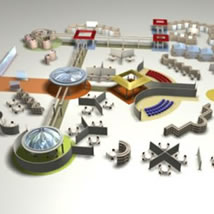 |
click on graphics and pictures for more background |
| It takes a navCenter to make a navCenter. In other words, navCenters are practiced into existence by the very means by which the navCenter being created is meant to function. This is not the way a capacity is typically brought into an organization. A functioning navCenter is a capacity and an organization like no other. It cannot be managed. It has to come into existence by an emergent process. It has to become a community of practice which can facilitate the organization and ValueWeb of which it is a part. This is not an inherently difficult process nor does it take a great deal of time. It does require rigor, collaboration and collaborative design. It requires installing the navCenter O.S. with integrity, learning how it operates, practicing it until mastery is accomplished, then changing it as required to fit the special circumstances and mission of the navCenter as it is then understood. If any of these steps are truncated, the integrity of the navCenter is sacrificed to the very conventions and habits-in-place which the navCenter is charged to educate, facilitate and help transition to a new level. |
|
|
| navCenters provide support and facilitation over the entire range of learning, creativity and innovation as well as the knowledge-base management and project management processes necessary for implementing initiatives including the incubation of new ventures. Mature navCenters become “the mind of the enterprise” freeing members to focus on creative work and the making of value. Much of what is considered executive work today is in reality picking up the pieces of a fractured organizational process. As organizations become larger they become increasingly grid locked and often subject to the directions of a few individuals. These are dangerous circumstances. navCenters provide a natural System Integration function which frees the work of an organization and allows management to return to real management. As a neutral space all members of an enterprise can collaborate without risk and then return to their Patch and do what they have to do. navCenters are both provider and exemplar of a new way of working and responding to 21st Century conditions and demands. |
|
|
| Ownership as it is commonly practiced will not work in regards to navCenter governance. Not if you want the full benefit of the Method. A property constituted navCenter is a self-managing, life-like system. To own, in the conventional way, a navCenter is to practice organizational slavery. Would you want to own and command your doctor or lawyer or any professional with whom you had a trusted fiduciary relationship in regards critical personal or business issues? The key act of stewarding a navCenter is to keep the other organizational structures of which it is a part from interfering with its function. Thus far, in the entire history of navCenters, there has been one “owner” - a commander of an Air Force Base - who understood this and acted accordingly. He reaped billions of benefits from a few million dollars of investment, achieved critical mission goals, and built an extraordinary example of human synergy and GroupGenius. Several corporations nearly achieved the same only to be thwarted by ownership. The rest “managed” to good, yet insufficient results. |
|
|
the ValueWeb of navCenters |
| We have found over the last 28 years that a navCenter, to remain viable, has to be an integral part of a network. And not just any kind of network - it has to be in a ValueWeb which is an unique kind of organization and practice. The members of the ValueWeb are independent agents which connect using the PatchWorks networking-collaborative process. The ValueWeb architecture and PatchWorks process combines the best attributes of a traditional organization with those of a network to emerge a new kind of organization capable of focused effort while maintaining great adaptability, flexibility and the capacity for continuous renewal of both the parts and the whole. This is a necessary ingredient for any organization which is to survive in our time as well as contribute to the ongoing improvement and transformation of any major part of our society. Rather than confront and challenge traditional structures, it is a better strategy to create new viable nodes and wire the entire assembly together in a new way allowing the existing parts to change on their own. |
|
|
|
|
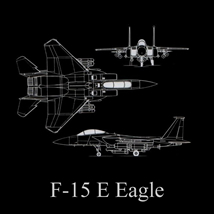 |
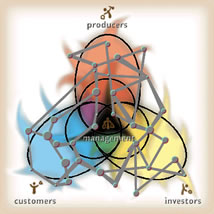 |
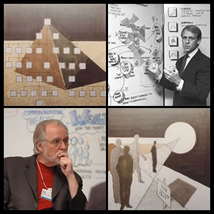 |
|
navCenter ValueWebs |
facilitating emergence |
ValueWeb Architecture |
Trandformation Process |
|
|
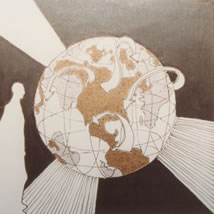 |
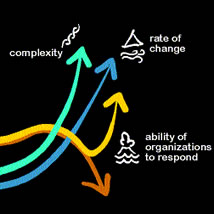 |
|
|
A Future by Design or... |
MG Taylor Mission |
Rate of Change-Complexity
|
PatchWorks Processes |
|
| The Articles, above, cover a number of the terms-of-art discussed to this point. They have many links to additional materials. These alone do not provide comprehensive coverage of the underlying basis of the navCenter practice. They do provide a beginning framework for discussion and further discovery. Like the majority of pieces on my personal web site, as is appropriate for an ongoing electronic Notebook, they are all works in progress. Please be aware of the percentage of completion noted and the SolutionBox designation for each item. |
click on graphics and pictures for more background |
|
statistics and narratives of the four examples: |
| The four navCenter examples provided here are points along a broad continuum. A navCenter can be small and have extraordinarily sophisticated technology or large with simple technology. A navCenter can be created to focus on large scale collaborative events, the management of multiple projects, R&D, learning, innovation, enterprise development, or the combination of all in various mixes. A navCenter can be 100% portable, built in place or a combination of the two. Ideally, every navCenter is designed to serve all knowledge-work, many prototyping functions, system integration roles and project management with easy reconfiguration as requirements change. The navCenter is a concept. The many built are examples of one and a possible template for new works. Each new navCenter project team has to study this prior art, revisit the vision, and then design the best solution for a specific time, place, circumstance, challenge and operating team. Only then is life breathed into the result. |
|
click on graphic for modle explaination |
| The 4 Step Re-Creative Process is a Model of the Taylor Method and illustrates the requirement of re conceiving each navCenter as they are designed, built and used. |
|
A full service RDS navCenter which can be deployed for a single event requiring a portion of the kit or, for several months, in full service mode |
|
capital costs |
usd |
usd |
|
| |
design and branding for unique user |
25,000 |
|
|
| |
storage, trailer and kitting set up |
65,000 |
|
|
| |
|
|
90,000 |
|
| |
Armature Tree system wiring and power control box |
89,000 |
|
|
| |
WorkFurniture |
423,000 |
|
|
| |
|
|
512,000 |
|
| |
lighting system |
72,000 |
|
|
| |
sound system |
15,000 |
|
|
| |
|
|
87,000 |
|
| |
computer and media system |
101,000 |
|
|
| |
|
|
101,000 |
|
| |
books and knowledge objects |
22,000 |
|
|
| |
planting kits |
9,000 |
|
|
| |
art objects and models |
18,000 |
|
|
| |
|
|
49,000 |
|
| |
shipping and first set up |
48,000 |
|
|
| |
misc. costs |
12,000 |
60,000 |
|
| |
|
|
|
|
| |
typical Total Capital costs @ medium level |
|
899,000 |
|
|
|
A full service Regional navCenter of large size with sophisticated media capability built within a four story high re purposed historic building |
|
capital costs |
usd |
usd |
|
| |
design, engineering and branding |
128,000 |
|
|
| |
leasehold improvements for 22,000 sq. ft. |
1,419,490 |
|
|
| |
|
|
1,547,490 |
|
| |
Armature system |
654,615 |
|
|
| |
WorkFurniture |
725,551 |
|
|
| |
|
|
1,380,166 |
|
| |
lighting system |
149,000 |
|
|
| |
sound system |
59,000 |
|
|
| |
|
|
208,000 |
|
| |
computer and media system |
223,000 |
|
|
| |
|
|
223,000 |
|
| |
books and knowledge objects |
62,000 |
|
|
| |
planting |
51,030 |
|
|
| |
art objects and models |
41,000 |
|
|
| |
|
|
154,030 |
|
| |
shipping and set up |
128,000 |
|
|
| |
misc. costs |
21,070 |
|
|
| |
|
|
149,070 |
|
| |
typical Total Capital costs @ medium level |
|
3,661,756 |
|
|
|
A full service Urban navCenter of medium size built within a modern office building |
|
capital costs |
usd |
usd |
|
| |
design, engineering and branding |
72,000 |
|
|
| |
leasehold improvements for 15,532 sq. ft. |
897,750 |
|
|
| |
|
|
969,750 |
|
| |
Armature system |
228,332 |
|
|
| |
WorkFurniture |
643,580 |
|
|
| |
|
|
871,912 |
|
| |
lighting system |
82,000 |
|
|
| |
sound system |
32,000 |
|
|
| |
|
|
114,000 |
|
| |
computer and media system |
123,000 |
|
|
| |
|
|
123,000 |
|
| |
books and knowledge objects |
43,000 |
|
|
| |
planting |
38,000 |
|
|
| |
art objects and models |
29,000 |
|
|
| |
|
|
110,000 |
|
| |
shipping and set up |
98,000 |
|
|
| |
misc. costs |
18,000 |
|
|
| |
|
|
116,000 |
|
| |
typical Total Capital costs @ medium level |
|
2,304,662 |
|
|
|
A full service Local navCenter of minimum size and capacity, less than the RDS example (above), able to deal with a few venues at a time |
|
capital costs |
usd |
usd |
|
| |
design, engineering and branding |
62,000 |
|
|
| |
leasehold improvements for 3,200 sq. ft. |
192,000 |
|
|
| |
|
|
254,000 |
|
| |
Armature system |
91,000 |
|
|
| |
WorkFurniture |
199,000 |
|
|
| |
|
|
290,000 |
|
| |
lighting system |
43,000 |
|
|
| |
sound system |
21,000 |
|
|
| |
|
|
64,000 |
|
| |
computer and media system |
90,000 |
|
|
| |
|
|
90,000 |
|
| |
books and knowledge objects |
32,000 |
|
|
| |
planting |
18,000 |
|
|
| |
art objects and models |
15,000 |
|
|
| |
|
|
65,000 |
|
| |
shipping and set up |
58,000 |
|
|
| |
misc. costs |
12,000 |
|
|
| |
|
|
70,000 |
|
| |
typical Total Capital costs @ medium level |
|
833,000 |
|
|
|
| The capital costs listed above, for the four type and scale of projects outlined above, estimate costs for the last quarter of 2010 through the first quarter 2011 assuming the location to be in San Francisco. Cost-to-own and cost-to-operate expenses, plus ROI models, are presented in page 3 of this documentation. |
|
| For an analysis of the capacity and capability of the four designs, click on the respective pictures above. While navCenters are designed and equipped to be extremely flexible and adaptable, each environment is designed based on a detailed understanding of the owner-user’s enterprise mission, work demand and resource base. |
|
key functions and attributes of a full service navCenter: |
environment |
process |
tooling |
| The location of a NavCenter is important. Within a rich social space or remote idyllic natural setting is optimal. In any setting, adjacency to hotel, eating and recreational accommodations is important. These are best reachable by foot. There are many support services necessary and they should be close. Directly within a standard business environment is the least effective. |
| a location with character, social symbol and value; easy to and or pleasant to get to; exemplifying the kind of world to be made by the work to be done within it; mix of nature and human made beauty; economically ecologically sustainable |
| High ceilings, wide column spacing, private access, easy loading and unloading, natural light, level floors, restrooms and food service areas internal to the Center, are qualities for the navCenter building. Old warehouses, lofts, restored 19th, early 20th Century buildings with e exposed traditional materials and simple forms are best. In modern office buildings, the first floor usually works. |
| break out of depressing low ceilings, ubiquitous sheet rock boxes and small enclosed spaces while still providing private, team and public areas; use texture and natural materials; reference history yet avoid time-place static symbols |
| An adoption of Herb Greene’s Armature concept to the layer between the large building space and the human scale of work. Armature holds the consistent sense of place while allowing enormous flexibility of other components. It establishes brand essence and prospect and refuge in the vertical plane. The armature structure provides lighting and encases wiring for power and technology. |
| enhance the vertical viewpoint; bring power technology and light where needed without disrupting the floor plane; use vertical elements to define sub-spaces; provide support for multimedia recording and display equipment |
| In the THERE to HERE of our 30 year development, the WorkWalls are a stand in for full multimedia input/output electronic work walls. Our present run-walk-run technology employs magnetic surfaces, which take markers, paint, pastels and stick on media, Hypertiles™ and symbols, in multiple layers. 7 feet high by 32 feet long WorkWalls can be moved by one person. |
| rolling, folding, curved and straight, architectural scale work surfaces for working big; easily adjustable to create areas for individuals, teams, groups; used for sketching, display, making graphics to be processed for instant publication |
| WorkFurniture™ and workPODs™ |
| Flexible environments which support many different modes of learning and work and constantly changing groupings of people, requires furniture that can rapidly adapt to new conditions. Even storage units have to move as does personal and group work spaces. Users have to be able to make these adjustments, great and small, without having to call in the experts else spontaneity is lost. |
| furniture pieces that can roll, dock and undock and adjust for different tasks; components that can be assembled into offices, then moved; pods that can open and close and roll to new locations; all made with human friendly wood |
| toys, models, books, art objects |
| Creative work fuels the economy and transforms society and it is also the highest form of adult play. The typical office, learning and conference spaces are dull and send the wrong messages to often being about conformity, posture, position, dominance and artificial symbols. Build an authentic architectural space which shows what it is for and dress it for fun. |
| stimulate the senses; challenge the mind; engage verbal, visual, kinesthetic thinkers; promote discovery; challenge perceptions; delight, enthrall, surprise; be what you are asking people to do; make collaboration and learning fun |
| Nature should not be “outside.” Human environments, if properly designed, built and managed, can merge the machine with the organic. Life-like ventures, which produce life-like results, work in life-like places. Plants are not decoration. Plants are living beings. Plants, flowing water and art bring ambient color, sounds and smell into the workspace to create an unique place. |
| create foreground, middle ground, background for every viewpoint in vertical, horizontal and time-to-walk space; mediate “hard” architectural elements with “soft” natural forms; punctuate intense work areas with “a walk in the park” |
| Work environment lighting ideally, for health and economy reasons, must employ as much natural lighting as possible. Artificial lighting has to be done in a way that avoids glare and provides a full spectrum light signature. In environmnets which shift to different set ups often, the lighting system has to be as adaptable in real time to match the moving WorkFurniture locations and the changing work flow. |
| ambient lighting for navigation; task lighting for each work type; high lighting to “shape” space; effect lighting to set moods and reflect seasons; all user controlled; shade and shadow to provide prospect and refuge; computer controls for managing the technology |
| navCenters have to be flexible in three ways: first, if installed in a rental property, the Armature and all WorkFurniture are designed to be removed ad reused preserving the maximum capital possible. Second, there must be flexibility between spaces for large group process events and day-to-day project work. Third, minute-to minute adjustability is essential in all work areas. |
| fluid space that does not look and feel like temporary space; real time adjustability with minimum time and effort spent; The ability of teams to form and disband on demand without losing a sense of individual place |
|
| embedding creative habits |
| Looking across time, race and cultural distinctions, sex, age, education, professions and belief systems, there are common habits shared by those universally considered to be exemplars of creativity. While not all the attributes of creativity, they constitute a predominately shared set. The navCenter embeds these attributes in every aspect of the environment and its work processes. |
| do not teach habits, practice them in all aspects of the work; express the values behind the habits in all aspects of how the environment is operated by facilitators and KnowledgeWorkers; make the habits “what we do together here" |
| Two collaborative sessions can have design work of apparent equal quality yet entirely different long term results. One many be an exercise “in the head” only and the other an experience which is transformational for the participants and that creates StrongMemory™ within the majority of them. The difference in ROI is orders of magnitude as is the persistence of long term implementation. |
| StrongMemory is based on how the brain associates different experiences; concepts, designs and plans which are connected to rich, highly connected, mind networks are strong; scattered, negative connections are weak and “fade” |
| establishing requisite variety |
| Cybernetics and Systems Theory developed the concept of requisite variety in the late 40s and early 50s. It states that a low variety system cannot deal with a high variety one. For them to be requisite there are two choices: to attenuate the high variety and/or augment the low. For success, the variety must be equal. The boundary design of the Zone of Emergence must accomplish this equation. |
| remove variety from a collaborative design session that does not add value to the outcome; add variety to the work group (number of members, expertise, knowledge objects, etc.) that does add value to the out come; monitor in real time |
| The structures and processes of organization are falling behind the increasing complexity and rate of change which is the aggregate result of humanity’s actions. This condition is chronic and systemic. Good efforts fail as new works are delivered into a different reality than design for. The time from concept to implemented capability must be radically compressed. |
| Chunk time, 50 people working for three, 12 hour days invested on a problem will out perform, by orders of magnitude, 18 two hour meetings over many months; limit debate; effective collaboration does not require agreement |
| The goal of the Method is to make a total environment, physical, mental, informational, work flow, etc., within which individuals, teams, Groups and large populations of users can work with minimal intervention and unintended consequences, effecting their result. We call this the Zone of Emergence. It is the boundaries of the zone which have to be managed not those doing the work. |
| maintain the integrity of the zone boundary; design and facilitate the work flow; demonstrate the way of working you want to see; support the work and remove distractions; monitor the energy of the group and provide feedback; do not interfere |
| Doing complete rapid cycles of work (iteration) with participation from many parts and scale of an organization (recursion) is at the heart of the Method. Shipping a product, to different parts and layers of the enterprise, getting feedback and doing a new cycle of work brings learning into the process allowing many small mistakes while avoiding a few big ones. |
| organize the work into many short iterations which ship a product and get instant feedback; employ multidisciplinary teams representing all stakeholders; employ PatchWorks architectures; expand the ValueWeb organically as the work requires |
| Based on Stuart Kauffman’s Patch Theory, the MGT PatchWorks process is designed to be embedded into every aspect of the navCenter physical, work and social architecture. PatchWorks is a means to wire networks to work thus escaping the organizational bookends of gridlock or anarchy. Complex, emergent systems cannot be understood or managed - they can be engaged. |
| organize all functions of the environment as patches; connect each human node to three nodes within“internal” patches and to nodes in the enterprise ValueWeb; “ship what you learn; use what you get; optimize your patch” |
| There are five types of the Taylor DesignShop process which range over a broad spectrum of challenges and their respective solutions. Each of these types require specific environmental factors and tooling to deal with different levels of complexity. The environment has to accommodate these variables, as well as individual work-style preferences in a daily, weekly, monthly mix of work. |
| provide the process as necessary given the nature of the work; adjust the environment as necessary to support the process; the environment adjusts to human requirements; humans do not conform to an environment based on a limiting model |
| The 10 Step Process establishes the architecture of the ventures knowledge base and is the engine of the project management function. It is employed in a DesignShop to capture and share the work in real time, provide feedback to the participants and produce documentations and work-products after the event. It is a key process to bring coherency to the ValueWeb. |
| hi-frequency, low magnitude, nod-to-node communication with iterative and recursive engagement with knowledge-base messages and knowledge products reduces the need for many invasive organizational “decisions” |
|
| If a meeting or collaborative design session is not documented, the first step in the 10 Step Process, it is largely wasted time. If people’s time can be afforded, so can the pennies on the dollar to record and appropriately distribute their work. There are various ways to do this, by users and KnowledgeWorkers. All have to be supported by the navCenter infrastructure. |
| user friendly multimedia self-documenting capability in all work areas with means to document and distribute in real time; knowledge-base smart algorithm system with passive and active capture and “push” publication processes |
| Capture is worth little if it is not displayed in real time as is relevant to the work then taking place. “Old” work has to be re-member-ed and recreated many times, throughout the ValueWeb for the maximum return on the human capital in-vest-ment to be achieved. Use all media forms in fast and slow time. “The right information to the right person, in the right form, at the right time” is the rule. |
| employ hand devices, personal computers, e-readers, kiosks, large screens, knowledge walls, models, library materials; meshwork electronic and hand made media; document who used what when; put results in knowledge-base. |
| There is a tendency to migrate to new media while dropping the old. This has unfortunate consequences. All media methods, and the tools which support them, have a direct impact on our cognitive processes. We each of have our preferences which effect how we perceive and conceive. To lean a new media is to literally become able to experience the world on a new way. |
| saturate the environment with multiple forms of media content using a wide variety of technologies; change content often in response to how users are responding to and using it; put the tools in the users hands to expand their cognitive ability |
| integration, mixing and feedback |
| The “management” of a PatchWorks-ValueWeb architecture is a systems integrations (S.I.) function not a command and control one. The goal is to facilitate the emergence of a self managed healthy eco-system. When there is “failure,” the strategic response is to provide new feedback loops and information channels to restore balance to the enterprise. |
| “information is the difference that makes a difference;” capture, integrate and provide feedback, by agreed upon rules, the user’s information to the user’s and their ValueWeb; create effective communication and feedback channels for their system |
| “Publish or perish” is true in practically all sectors of human effort not just the academy. In a navCenter, publishing is a continuous process as an integral aspect of the creative work. The archive is drawn upon daily. These are knowledge-agents brought to life by a system and protocol which imbeds their voice in the on-going work of the Center as well as the world at large thus making a virtuous cycle. |
| support the full range of publication styles and means; publish high frequency, low magnitude as well as occasional large formal works; track readership and respond appropriately; incorporate ValueWeb ideas in real time with the work being done |
| Given the complexity of today’s world, the ability to build and test models of all kinds be they physical, mathematical, simulations, thought experiments, scenarios, processes and protocols, is an integral part of the learning, design and project management processes. The technical competency of doing modeling in real time is a requirement of a full function navCenter. |
provide tools, materials and processes for rapid conceptual prototyping; construct models of modular, reusable components; provide real time knowledge-worker-expert support from Center support network; keep the models
|
| Team workspace and individual workspace should not be confused. To do so supports nether mode of working. teamPatches often have to be set up for extended periods of time so that there is team-place and the ability to work effectively as members come and go. If individuals have personal work-niches, they do not have to bring personal work to the team areas which disrupts the team process. |
| places for individuals, places for teams, places for groups; all integrated, each distinct; learning, designing, thinking, deciding; sharing, testing, challenging, changing structures and habits are different modes when performed alone, in a team or a group |
| True augmentation systems and devises have long been a dream. To date they have been too expensive, cumbersome and lacked ubiquity. New products are shattering these constraints. Their predominate use largely reinforces old habits rather than augmenting human creativity and group collaboration. Each work process and and each person requires an unique meshwork configuration. |
| off-the-shelf technology with new protocols and processes building an intelligent agent system which automatically forms and facilitate effective PatchWorks architectures; leverage the technology which walks through the door |
| RemotePresence & Collaboration |
| RemotePresence™ is a wall of flat screens between different locations which are always on so that the activities in each location can be seen and heard by all. These are windows into each other’s realm. Remote Collaboration™ is the ability to work virtually with another location while being free of spatial restriction. These are a hardware, software and process meshwork. |
| make key ValueWeb nodes a real time living presence promoting hands free, at-the-water cooler spontaneous dialogs; break virtual conferencing out of the box of talking heads; put kinesthetic energy into virtual work |
|
| The functions outlined above are not exhaustive. On page 2, more functions are outlined. This page provides 27 snapshots of key attributes of the O.S. which have to be in place for the System and Method to function fully. How this is done draws from an infinite range of possibilities. The purpose of the environment and toolset is to provide an Armature so the processes employed are supported and can flow seamlessly. The processes facilitate - to make easy - those working in and connected to the environment. It is the quality of their experience that counts. The purpose of the Taylor Method is to provide a different quality and the sole measure of success is the value of the work produced. |
|
| On pages 2, 3, 4 & 5 go into greater depth of what is outlined on this page as well as add new information. It is important that you follow the links even when sometime they take you to what may appear to be other realms. Follow what interests you and stop when it does not. This is not a document to be read like a book. It is better to read it and compare it with your own experience, then iterate, rather that try to take it all in whole all at once. These pages are a documentation of over 30 years experience of hundreds of people supporting thousands of DesignShop events and follow on work in numerous environments crafted to support collaborative innovation. Reading and thinking builds an image. Experience adds the flesh. |
|
|
|
|
|
link coming |
MGT Modeling Language |
Building ValueWebs |
Creative Augmentation |
KnowledgeWorker Network |
link coming |
|
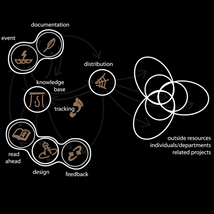 |
link coming |
Cube Office System |
Creative Habits |
Ten Step Process |
IP |
link coming |
link coming |
|
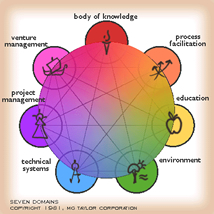 |
Project Stories |
Types of DesignShops |
workPODS |
7 Domains Model |
| This page provides an overview of the navCenter concept, practice and history. Page 2, Using the Environment provides additional detail regarding the various venues and uses to which a navCenter can be put. Page 3, Operating Costs and Economics provides additional detail on the cost to build and operate a navCenter and also various ownership venues and ways of achieving and measuring Return on Investment. This is equally important in a non provide environment as a for profit venture. Page 4, Installing the O.S. goes deeper into the principles of ownership, management and practicing the craft of doing the work process for self and ValueWeb users of the navCenter. Page 5, Presidents and References provides documentation on the Method, its philosophical and scientific basis as well as the many giants whose shoulders the practice stand on. |
| The five pages provide a comprehensive overview. This said, it is important to realize that only experience of the navCenter and its methods provide the true story in depth. This is the nature of the system. The only effective way to acquire a navCenter is to get into one with a highly experienced team of designers, facilitators and KnowledgeWorkers and co-design with them the center you want and then use it. While a navCenter can be built in one to four months, the entire start up process takes a minimum of a year to get to the first level of competency and viable practice. |
| Since the apprenticing to, and designing with, the Method involves DesignShop events, supported by an experience team which are focused on real projects central to your enterprise, properly stewarded the navCenter can be long paid for by the time it is built and brought to full operation. |
|
| Even the brief overview provided on these pages can look overwhelmingly complex. It is not. It is the issues our modern society is grappling with that are complex - a complexity that is overwhelming our best institutions. The Method presented here is in fact a radical simplification of how we do work today. It is the “method,”which we all grew up in, which has evolved from the past adding techniques and tools onto one another for decades, that has become impossibly baroque and cumbersome. |
| Imagine if the existing way of working was explained in a few pages like this to someone who was not familiar with many of its underlying design assumptions. The good news is this: the people coming to work within the NavCenter environment do not need to know all this to be effective in their work. They learn by doing. The facilitators and KnowledgeWorkers have to know the theory and the practice in depth yet they also learn by doing the work with those who have mastered the trade. |
| Those who are to own a NavCenter and apply it to their areas of interest must have an overview and grasp the pattern language of the system in order to participate in the design and implementation of the capability and to effectively steward it over time. They also will come to knowing by doing this work together with those who have built many navCenters. In fact, no one ever learns the System and Method as a whole cloth and in the detail of every thread. This is impossible. You do not need to know every aspect of a car to drive it. Yet your ValueWeb as a whole does have to know it if the system “car” is to remain on the road. Think of these pages as a drivers manual and it all makes sense. |
|
|
|
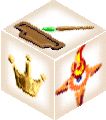
SolutionBox
voice of this document:
INTENT • POLICY • PROGRAM
|
|
| |
click on graphic for explanation of SolutionBox |
posted:
September 14, 2010 • updated November 15, 2010 • 8:15 AM @ flying from Calgary to San Francisco |
© Matt Taylor, MG Taylor Corporation, tsmARCHITECTURE, Athenaeum International, all rights reserved
This is intellectual property which constitutes a vested interest in all projects shown |
|
